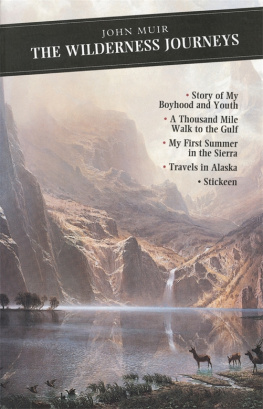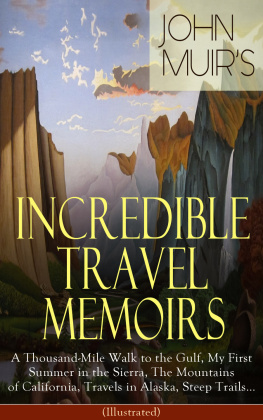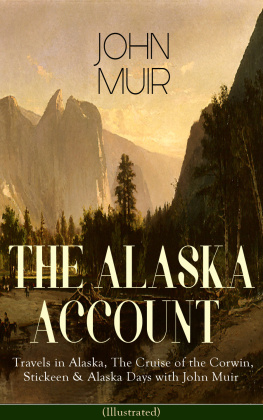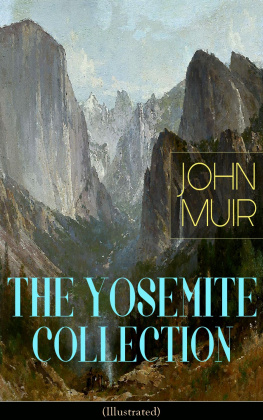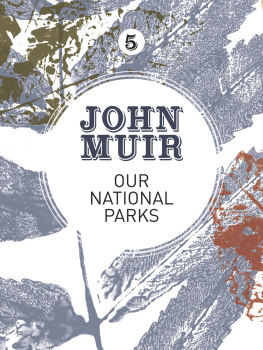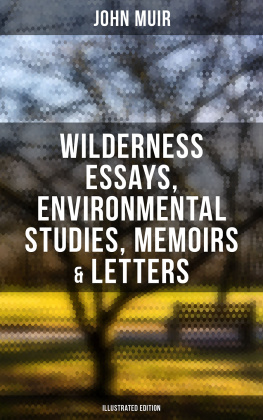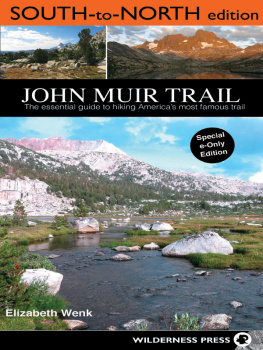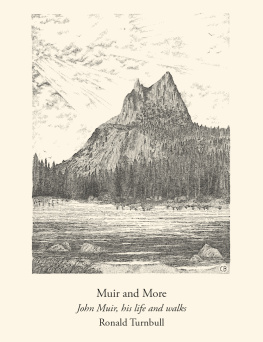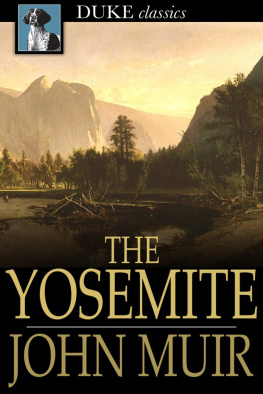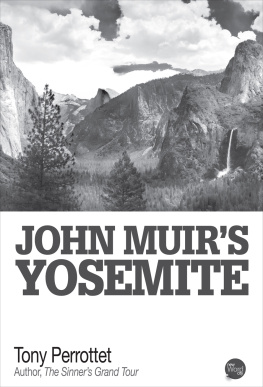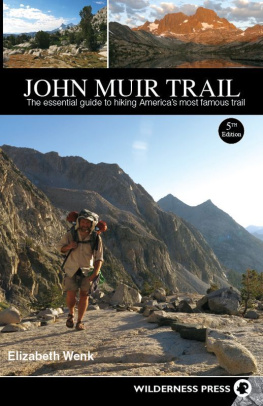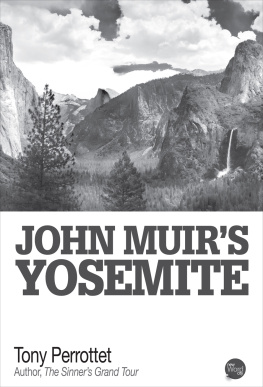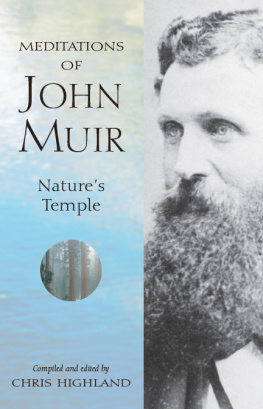John Muir - The Wilderness Journeys
Here you can read online John Muir - The Wilderness Journeys full text of the book (entire story) in english for free. Download pdf and epub, get meaning, cover and reviews about this ebook. year: 2009, publisher: Canongate Books, genre: Non-fiction. Description of the work, (preface) as well as reviews are available. Best literature library LitArk.com created for fans of good reading and offers a wide selection of genres:
Romance novel
Science fiction
Adventure
Detective
Science
History
Home and family
Prose
Art
Politics
Computer
Non-fiction
Religion
Business
Children
Humor
Choose a favorite category and find really read worthwhile books. Enjoy immersion in the world of imagination, feel the emotions of the characters or learn something new for yourself, make an fascinating discovery.
- Book:The Wilderness Journeys
- Author:
- Publisher:Canongate Books
- Genre:
- Year:2009
- Rating:4 / 5
- Favourites:Add to favourites
- Your mark:
- 80
- 1
- 2
- 3
- 4
- 5
The Wilderness Journeys: summary, description and annotation
We offer to read an annotation, description, summary or preface (depends on what the author of the book "The Wilderness Journeys" wrote himself). If you haven't found the necessary information about the book — write in the comments, we will try to find it.
The Wilderness Journeys — read online for free the complete book (whole text) full work
Below is the text of the book, divided by pages. System saving the place of the last page read, allows you to conveniently read the book "The Wilderness Journeys" online for free, without having to search again every time where you left off. Put a bookmark, and you can go to the page where you finished reading at any time.
Font size:
Interval:
Bookmark:
This omnibus edition restores to Scottish print The Story ofMy Boyhood and Youth and My First Summer in the Sierra, by John Muir, published for the first time as Canongate Classics in 1988. A Thousand Mile Walk to the Gulf and Travels in Alaska deal with the other great autobiographical journeys of Muirs life. The inclusion of Stickeen may at first seem odd, for it re-tells an incident included in Travelsin Alaska; but told as a short story it reveals an aspect of Muirs concern for animals that is largely unknown in Britain, where it has rarely been available.
Together, these five books chart the epic journeys on which John Muir explored the geography and ecology of the American continent, from the snowy Alaskan glaciers to the alligators and orchids of the Florida swamps. They record the Odyssey of this great Scottish-American from humble origins in Victorian Scotland to his eventual enthronement as the elder statesman of Conservation: adviser to Presidents, lauded with honours by the universities, scientists and philosophers of his day.
In America John Muir is remembered as a climber, explorer, geologist, botanist and writer; but above all as the pioneer of conservation. In the 1870s, before mountaineering existed as a sport in the USA, he made the first ascent of Mt Ritter (13,000 ft), the first ascent by the eastern route of Mt Whitney (14,500 ft), and early ascents of Mt Shasta (14,400 ft) and Mt Rainier (14,500 ft). He was first to ascend Cathedral Peak, a hazardous pinnacle in Yosemite National Park, and climbed many other peaks in the Sierra Nevada range. However, it was not the desire for fame, or bagging summits, which led him to risk his life in scaling these heights; he climbed in order to understand the geography of the unmapped areas he was exploring. But a deeper need also drew him to these remote summits, for here he found the beauty, cosmic mystery and spiritual insight which gave him his deepest fulfilment. Along the way he unwittingly pioneered clean climbing for American mountaineers, for he normally climbed without crampons, ropes or pitons.
A self-taught geologist and glaciologist, he was the first to discover living glaciers in the High Sierra and to propose their role in sculpting entire mountain ranges. His theory, that slow-grinding glaciers had gouged out Yosemite Valley over vast epochs of time, was ridiculed by Josiah Whitney, the patriarch of Californian geology, who held to the catastrophist doctrine, that giant earthquakes had dropped the valley floor. Whitney dismissed Muirs ideas with contempt: What does the sheep-herder know about geology?, but Louis Agassiz, the father of glaciology, later proved Muir correct. As a botanist and pioneer-ecologist Muir was consulted by the great scientists of his day, notably Asa Gray of Harvard and Joseph Hooker of Kew. He guided them on expeditions of discovery and they even named some of the plants he led them to in his honour! Ralph Waldo Emerson, the transcendental philosopher of New England, journeyed over 3,000 miles to visit Muir in the hang-nest, a wooden shack he had built in Yosemite. Emerson wrote that this self-reliant young Scot had the most original mind and powerful intellect of any man he had met in America; they became life-long friends.
But it is as the founder of the conservation movement, the first person to call clearly for the conservation and protection of wilderness and wildlife, that we remember John Muir. By the time of his death in 1914 he had become an almost mythic figure in the American pantheon, where today he ranks alongside Emerson, Thoreau, Lincoln and Kennedy as father of the national parks. John Muir is truly revered, not as some intellectual fossil, enshrined in a marble hall of fame, but as a living spirit an environmental Zeitgeist whose words and ideas reverberate through the conservation movement on both sides of the Atlantic with increasing resonance and relevance.
Americans have named over 200 sites in his honour, including: Muir Glacier and Mount Muir in Alaska, Muir Woods and Muir Beach near San Francisco, and the John Muir Wilderness and John Muir Trail in the High Sierra. In 1964, Congress designated his Martinez home The John Muir National Historic Site, in recognition of his campaigns and the books in which he celebrated the natural heritage of the United States. This is just one of over 340 historic sites and parks, comprising over 80 million acres of wild land, cared for by the National Park Service, which Muir himself helped create. At Marquette County, Wisconsin, the John Muir Memorial Park is laid out near the Muir homestead at Fountain Lake. A granite slab among the wildflowers declares:
JOHN MUIR, Foster son of Wisconsin born in Scotland April 21, 1838
He came to America as a lad of eleven, spent his teen years in hard work clearing the farm across this lake, carving out a home in the wilderness. In the sunny woods, overlooking a flowery glacial meadow and a lake rimmed with water lilies, he found an environment that fanned the fire of his zeal and love for all nature, which, as a man, drove him to study, afoot, alone and unafraid, the forests, mountains and glaciers of the west to become the most rugged, fervent naturalist America has produced, and the Father of the National Parks of our country.
After Muirs death President Teddy Roosevelt wrote:
His was a dauntless soul. Not only are his books delightful, not only is he the author to whom all men turn when they think of the Sierras and Northern glaciers, and the giant trees of the California slope, but he was also what few nature-lovers are a man able to influence contemporary thought and action on the subjects to which he had devoted his life. He was a great factor in influencing the thought of California and the thought of the entire country so as to secure the preservation of those great natural phenomena wonderful canyons, giant trees, slopes of flower-spangled hillsides our generation owes much to John Muir.
President Theodore Roosevelt, January 6, 1915
Awareness of that historic debt remains undimmed in the national consciousness. On April 21, 1988, the 150th anniversary of Muirs birth it was resolved:
by the Senate and House of Representatives of the United States of America: that April 21, 1988, is designated as John Muir Day, and the President is authorized and requested to issue a proclamation calling upon the people of the United States to observe such day with appropriate ceremonies and activities.
Congress acknowledged Muirs role in conserving wilderness and in stressing an ecologically sound environment as the basis of the quality of life for all people. The Rio World Summit on the Environment in 1992 highlighted the concept of sustainability as the acid-test for survival in the coming millennium; but John Muir was writing about the sustainable use of the worlds natural resources as long ago as 1870.
These books record expeditions of courage, endurance and extreme hardship; few would undertake them lightly, even today, when rescue is only a mobile-phone away. Muir traversed unmapped wildernesses, the country of bears and mountain lions, with no prospect of help or of rescue beyond total self-reliance. He went alone, equipped only with hob-nailed boots, an old blanket, a hand-lens, pencil and notebook. His food was a sack of brick-hard bread, and a screw of tea to add to the river water. He never carried a gun to hunt game, or protect himself from grizzlies, pumas and desperados.
The Story of My Boyhood and Youth (1913) was written when Muir was over seventy, but he paints a sparkling picture of his Dunbar days with clarity and a wry humour. The opening paragraph is perhaps the most famous evocation of a childs vision of nature ever written:
When I was a boy in Scotland, I was fond of everything that was wild, and all my life Ive been growing fonder and fonder of wild places and wild creatures. Fortunately, around my native town of Dunbar, by the stormy North Sea, there was no lack of wildness with red blooded playmates, wild as myself, I loved to wander in the fields, to hear the birds sing, and along the seashore to gaze and wonder at the shells and seaweeds, eels and crabs in the pools among the rocks when the tide was low.
Font size:
Interval:
Bookmark:
Similar books «The Wilderness Journeys»
Look at similar books to The Wilderness Journeys. We have selected literature similar in name and meaning in the hope of providing readers with more options to find new, interesting, not yet read works.
Discussion, reviews of the book The Wilderness Journeys and just readers' own opinions. Leave your comments, write what you think about the work, its meaning or the main characters. Specify what exactly you liked and what you didn't like, and why you think so.

